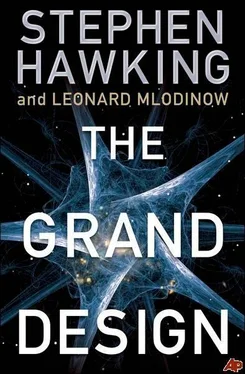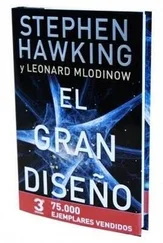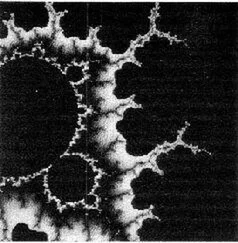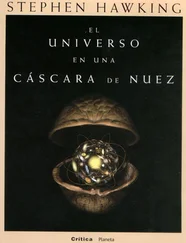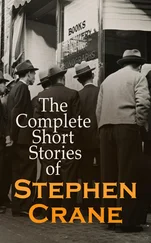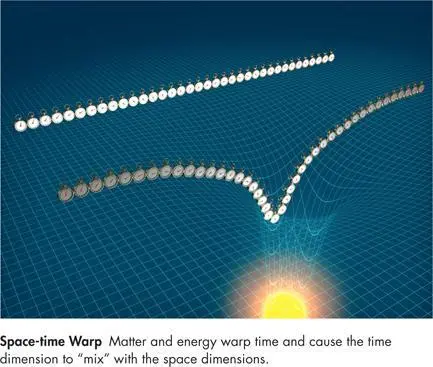
Armed with these ideas, let’s return to the issue of the beginning of the universe. We can speak separately of space and time, as we have in this discussion, in situations involving low speeds and weak gravity. In general, however, time and space can become intertwined, and so their stretching and compressing also involve a certain amount of mixing. This mixing is important in the early universe and the key to understanding the beginning of time.
The issue of the beginning of time is a bit like the issue of the edge of the world. When people thought the world was flat, one might have wondered whether the sea poured over its edge. This has been tested experimentally: One can go around the world and not fall off. The problem of what happens at the edge of the world was solved when people realized that the world was not a flat plate, but a curved surface. Time, however, seemed to be like a model railway track. If it had a beginning, there would have to have been someone (i.e., God) to set the trains going. Although Einstein’s general theory of relativity unified time and space as space-time and involved a certain mixing of space and time, time was still different from space, and either had a beginning and an end or else went on forever. However, once we add the effects of quantum theory to the theory of relativity, in extreme cases warpage can occur to such a great extent that time behaves like another dimension of space.
In the early universe-when the universe was small enough to be governed by both general relativity and quantum theory-there were effectively four dimensions of space and none of time. That means that when we speak of the “beginning” of the universe, we are skirting the subtle issue that as we look backward toward the very early universe, time as we know it does not exist! We must accept that our usual ideas of space and time do not apply to the very early universe. That is beyond our experience, but not beyond our imagination, or our mathematics. If in the early universe all four dimensions behave like space, what happens to the beginning of time?
The realization that time can behave like another direction of space means one can get rid of the problem of time having a beginning, in a similar way in which we got rid of the edge of the world. Suppose the beginning of the universe was like the South Pole of the earth, with degrees of latitude playing the role of time. As one moves north, the circles of constant latitude, representing the size of the universe, would expand. The universe would start as a point at the South Pole, but the South Pole is much like any other point. To ask what happened before the beginning of the universe would become a meaningless question, because there is nothing south of the South Pole. In this picture space-time has no boundary-the same laws of nature hold at the South Pole as in other places. In an analogous manner, when one combines the general theory of relativity with quantum theory, the question of what happened before the beginning of the universe is rendered meaningless. This idea that histories should be closed surfaces without boundary is called the no-boundary condition.
Over the centures many, including Aristotle, believed that the universe must have always existed in order to avoid the issue of how it was set up. Others believed the universe had a beginning, and used it as an argument for the existence of God. The realization that time behaves like space presents a new alternative. It removes the age-old objection to the universe having a beginning, but also means that the beginning of the universe was governed by the laws of science and doesn’t need to be set in motion by some god.
If the origin of the universe was a quantum event, it should be accurately described by the Feynman sum over histories. To apply quantum theory to the entire universe-where the observers are part of the system being observed-is tricky, however. In Chapter 4 we saw how particles of matter fired at a screen with two slits in it could exhibit interference patterns just as water waves do. Feynman showed that this arises because a particle does not have a unique history. That is, as it moves from its starting point A to some endpoint B, it doesn’t take one definite path, but rather simultaneously takes every possible path connecting the two points. From this point of view, interference is no surprise because, for instance, the particle can travel through both slits at the same time and interfere with itself. Applied to the motion of a particle, Feynman’s method tells us that to calculate the probability of any particular endpoint we need to consider all the possible histories that the particle might follow from its starting point to that endpoint. One can also use Feynman’s methods to calculate the quantum probabilities for observations of the universe. If they are applied to the universe as a whole, there is no point A, so we add up all the histories that satisfy the no-boundary condition and end at the universe we observe today.
In this view, the universe appeared spontaneously, starting off in every possible way. Most of these correspond to other universes. While some of those universes are similar to ours, most are very different. They aren’t just different in details, such as whether Elvis really did die young or whether turnips are a dessert food, but rather they differ even in their apparent laws of nature. In fact, many universes exist with many different sets of physical laws. Some people make a great mystery of this idea, sometimes called the multiverse concept, but these are just different expressions of the Feynman sum over histories.
To picture this, let’s alter Eddington’s balloon analogy and instead think of the expanding universe as the surface of a bubble. Our picture of the spontaneous quantum creation of the universe is then a bit like the formation of bubbles of steam in boiling water. Many tiny bubbles appear, and then disappear again. These represent mini-universes that expand but collapse again while still of microscopic size. They represent possible alternative universes, but they are not of much interest since they do not last long enough to develop galaxies and stars, let alone intelligent life. A few of the little bubbles, however, will grow large enough so that they will be safe from recollapse. They will continue to expand at an ever-increasing rate and will form the bubbles of steam we are able to see. These correspond to universes that start off expanding at an ever-increasing rate-in other words, universes in a state of inflation.

As we said, the expansion caused by inflation would not be completely uniform. In the sum over histories, there is only one completely uniform and regular history, and it will have the greatest probability, but many other histories that are very slightly irregular will have probabilities that are almost as high. That is why inflation predicts that the early universe is likely to be slightly nonuniform, corresponding to the small variations in the temperature that were observed in the CMBR. The irregularities in the early universe are lucky for us. Why? Homogeneity is good if you don’t want cream separating out from your milk, but a uniform universe is a boring universe. The irregularities in the early universe are important because if some regions had a slightly higher density than others, the gravitational attraction of the extra density would slow the expansion of that region compared with its surroundings. As the force of gravity slowly draws matter together, it can eventually cause it to collapse to form galaxies and stars, which can lead to planets and, on at least one occasion, people. So look carefully at the map of the microwave sky. It is the blueprint for all the structure in the universe. We are the product of quantum fluctuations in the very early universe. If one were religious, one could say that God really does play dice.
Читать дальше
